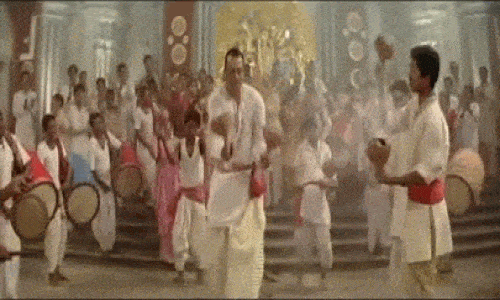My childhood memories do not include a bunch of friends giggling at a sleepover party or celebrating birthdays at Mc Donald’s – the then cool hangout zone. They do not involve a lot of heartwarming, tear dropping, hair brushing, Zac Effron loving moments. They are more about the breeze that carried the seductive fragrance of sandalwood smoke and smoldering Dhunachi. And how the feet frantically moved to the maddening beats of dhak! Lost in the enigmatic eyes of the goddess Durga, all the young and old Bangali babus & bibis would get together once in a year to hail victory over the evil.
When I indulge in my past, the memories which to date tickle my heart are the innumerable euphoric moments that came along with Durga Puja – the carnival of positivity. Falling somewhere in the months of September and October, in sync with North India’s ‘nine days of vrat ka khaana’, Durga Puja has its own charm. You can be an atheist like me and still honor the grandeur of the lady standing upright with her Trishul piercing through the devil’s chest as she sits on her wild throne; the lion.
You can absolutely not give a tiny rat’s ass for the religious sentiments behind this festival and still be awe-stricken by Durga’s magnificent posture as each of her ten hands hold a weapon to vanquish the evil. The eight-year-old me used to stand with my ma and baba in front of her like a lost child and observed her from head to toe. Going from left to right, I would count all her children standing much like today’s avengers, only more graceful – Kartik on the flamboyant peacock; Saraswati on a mesmerizing swan; Lakshmi being all snobby on an owl, and Ganesh resting on a mouse.
The folklore is that Durga visits her parent’s house every year for four days and she leaves on the tenth day of Navraatras (Vijay Dashami). And those four days of feasting were and still are the most awaited. FYI, we do not comprehend the word ‘vegetarian’, and yes, even our pujas include mutton biriyani and fish cutlets.
I remember the big hyena-like grin on my plump face when ma used to take me out for our special and most expensive shopping spree, almost forgetting the middle-class stature. The entire year’s savings would be spent carefully on clothes, jewelry, syrupy sweets, dry sweets, and more sweets. By the way, if Roshogolla is all you know from our sweet palette, then you know nothing!
I owed my best duppattas and flowy frocks to this time of the year. Girls of my age wore kohl on their eyes; mine always had spectacles, the really expensive ones though. Their mothers had the time to dress them up. But ma is more of a ‘let’s do this shit’ kind of a woman and mostly spent her time backstage preparing the anchoring script, program sequences, and howling at the lighting guy. Why? Because being an active member of the cultural committee was a tradition back then. She loved directing her favorite Tagore reads, the rehearsals of which took place on a fellow pujo-maniac’s balcony or drawing room with me providing impromptu suggestions.
We would rehearse for at least an entire month before bringing a production to life. I loved all those rehearsals, even the ones that had no role for me. Simply watching people throwing dialogues and pausing for the dramatic scenes excited me. I mostly did dance sequences with kids of my age taught by various aunties. And right before the program, the tiny me would sit patiently as the aspiring Durga Puja makeup artists (mostly aunties and didis) would apply foundation on my face followed by the blush on, kumkum and mustaches whenever I played a guy. Running around with a half-done beard and a dhoti would forever remain an unchallenged memory.
And finally, the stage – the very sacred stage – built inside the massive ornamented pandal, rightfully placed near the main puja hall would call us out for our ghungroos to sing a rhythm. From folk songs to dramatic performances, nothing was off the table.
The culture of performing arts during puja and poetry recitation from the golden pages of Bangla literature have always been two prime factors why Bong kids grow up to be slightly nerdy with an inclination towards the artistic side of life.
As a shy-awkward kid with not an iota of popularity in school to bank upon, this time of the year gave me a voice. I was not the neglected weird kid on the field then. Nobody was! Dancing to Tagore’s music and tons of other artists, we all were performers! For four freaking days, we all, from seven to seventy, were painters, poets, singers, dancers, and athletes. And each day would end with Bangali adda.
(Bangali adda: this is how we describe our long chats, which are exclusively always about politics and how spineless the present generation is, literature, sarees, money spent, and what all things to do next year ).
Right from the Navratra’s fifth day when the idol is installed in its rightful place till the day of Visarjan, these handful days of innocence cared for no sorrows.
The goddess bids her farewell and proceeds towards her husband’s home every year on the last day of the celebration, leaving all of us gloomy.
But, do you know what keeps us going?
“Aashcche bochhor aabaar hobe.” (She’ll visit again next year…)
Featured image: source


